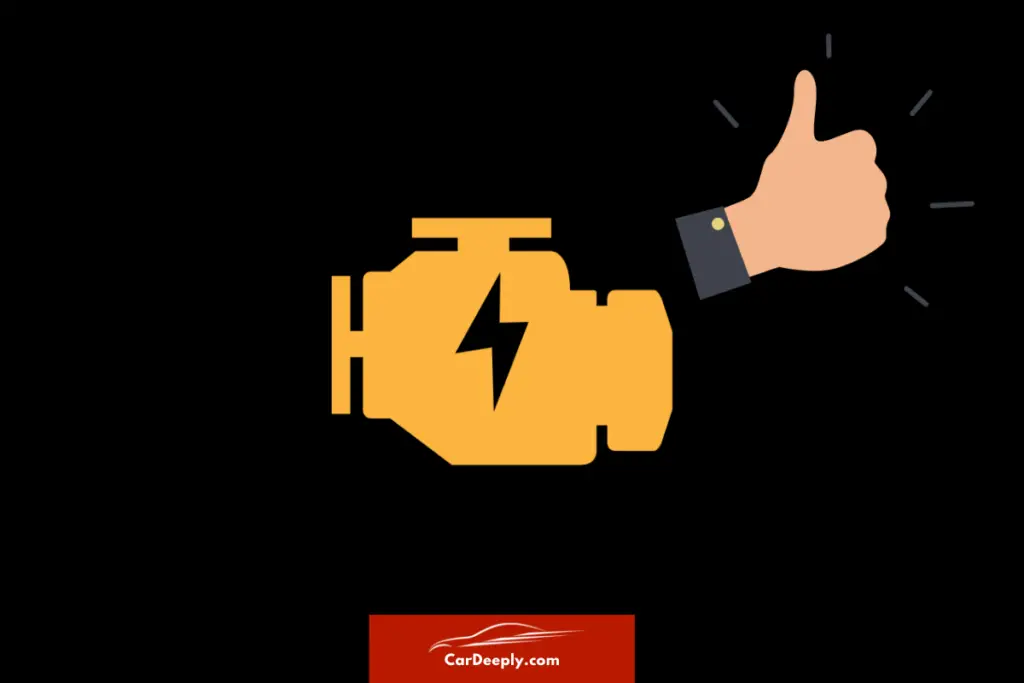Ever had your check engine light on, but your car seems to run just fine? Ignoring it could lead to serious, costly issues down the road.
In this article, we’ll help you understand:
- Why might the light be on
- Potential problems it could indicate
- Practical steps to address it
Don’t gamble with your vehicle’s health. Dive in now to prevent future headaches and keep your car running smoothly.
Advertising links are marked with *. We receive a small commission on sales, nothing changes for you.
Key Takeaways

- The check engine light is a warning from your car’s onboard diagnostics system.
- Common triggers include a loose gas cap, faulty O2 sensor, or transmission problems.
- A flashing light indicates a serious issue, while a steady light is usually less urgent.
- Diagnosing the case involves an OBD-II scanner and, often, a professional mechanic.
- Ignoring the check engine light can lead to more serious, costly problems.
Understanding the Check Engine Light
Ever wondered what that little engine symbol on your dashboard means?
That’s your car’s way of saying, “Hey, something’s not right here!” It’s called the check engine light.
What it is
The check engine light is part of your car’s onboard diagnostics system. When it lights up, the system detects a problem that could affect your car’s emissions, performance, or overall health.
How it works
Your car is full of sensors. These sensors monitor everything from your engine’s temperature to the amount of unburned oxygen in your exhaust. When one of these sensors detects something unusual, it sends a signal to your car’s computer.
If the issue is serious enough, the computer turns on the check engine light.
Importance of not ignoring it
Ignoring the check engine light is like neglecting a toothache. Your mouth still works fine, but a serious problem could be brewing. Ignoring it won’t make it go away. It could make things worse.
Common Reasons for the Check Engine Light
Your check engine light is on, but your car is running fine. What gives? There could be several reasons. Here are a few common ones:
Loose or faulty gas cap
Yes, something as simple as a gas cap can trigger the check engine light. If it’s loose or faulty, it can allow fuel vapors to escape, throwing off your car’s fuel system.
Faulty oxygen (O2) sensor
Your car’s O2 sensor measures the amount of unburned oxygen in your car’s exhaust. If it’s not working properly, it can cause your engine to burn more fuel than needed.
Problems with the catalytic converter
The catalytic converter is key to your car’s emissions control system. It converts harmful gases into less toxic substances. If it’s not working properly, it can cause your vehicle to fail an emissions test.
Issues with the emission control system
Your car’s emission control system helps reduce the amount of pollution your vehicle produces. If this system has a problem, it can cause your check engine light to come on.
Transmission problems
Transmission problems can also trigger the check engine light. These can range from minor issues, like a faulty sensor, to major problems, like a failing transmission.
Remember, these are just a few reasons your check engine light might be on. If your check engine light is on, it’s important to get it checked out by a professional as soon as possible.
Ignoring it could lead to more serious and more expensive problems down the road.
Is the Check Engine Light an Emergency?
Now that we’ve got a handle on why that pesky check engine light might be on let’s talk about what to do when it happens.
Is it an emergency?
Should you pull over immediately?
Or can it wait until you’ve finished your road trip?
When to worry
If your check engine light comes on and it’s flashing, that’s your car’s way of saying, “Hey, this is serious!” A flashing check engine light usually means there’s a severe engine misfire.
This can lead to excessive heat in the catalytic converter and cause damage. In this case, you should immediately reduce your speed and seek professional help.
When it might be a minor issue
On the other hand, if the light is steady, it’s usually not an emergency. But that doesn’t mean you should ignore it. A steady check engine light is still a sign that something’s wrong.
It could be a minor issue, like a loose gas cap or a sign of something more serious. Either way, getting it checked out as soon as possible is best.
Diagnosing a Check Engine Light
So, your check engine light is on. What’s next? It’s time to figure out what’s causing it.
Steps to diagnose
The first step in diagnosing a check engine light is to use an OBD-II scanner. This device can read the trouble codes from your car’s computer. These codes can tell you what’s causing the light to come on.
Importance of a professional diagnosis
While an OBD-II scanner can give you a general idea of what’s happening, it’s not a substitute for a professional diagnosis. A professional mechanic has the tools and knowledge to diagnose the problem and recommend the best action accurately.
What to Do if a Check Engine Light Comes On
You’ve got the diagnosis; now what? Here’s what to do if your check engine light comes on.
DIY steps
If the problem is simple, like a loose gas cap, you can fix it yourself. Just ensure the lid is tight and see if the light goes off.
When to bring it to a professional
If the problem is more serious or you’re uncomfortable repairing yourself, it’s time to bring your car to a professional. They can fix the problem and reset the check engine light.
Frequently Asked Questions
Can I continue driving when the check engine light comes on?
Yes, you can continue driving if the check engine light is steady. However, getting your car checked as soon as possible is best. If the light is flashing, it’s a sign of a serious problem, and you should reduce your speed and seek help immediately.
How long can I drive with the check engine light on?
There’s no specific time frame, but driving for long periods with the light on is not recommended. The longer you ignore it, the higher the chance of causing serious damage to your car.
Can a check engine light come on due to low fuel?
No, a check engine light won’t come on due to low fuel. However, running your car on a very low fuel level can cause the fuel pump to overheat and fail, triggering the light.
Can a check engine light come on due to weather changes?
Drastic weather changes can affect tire pressure; triggering the check engine light and checking your tire pressure when the weather changes is always a good idea.
Can a check engine light reset itself?
Yes, if the issue that caused the light to come on is resolved, it can turn off by itself. However, getting a professional to check it out is always best to ensure the problem is truly fixed.
Conclusion
The check engine light is more than just annoying on your dashboard. It’s a warning sign that something’s not right with your car. Ignoring it could lead to serious, costly problems down the road.
So, if your check engine light comes on, don’t ignore it. Get it checked out and keep your car running smoothly.

Sebastian loves convertibles and drove a BMW 335i for a long time (325 hp is just a dream). Today, with two children, he is more concerned with SUVs and family-friendly vehicles. In addition to an Audi A4 Avant, he also drives a Cupra Formentor VZ – even as a family man, you can’t do without speed. Get to know Sebastian better and visit the About Us page.
Advertising links are marked with *. We receive a small commission on sales, nothing changes for you.
